Work Lesson Plan – A Complete Science Lesson Using the 5E Method of Instruction
By the end of this lesson plan about work, students will be able to contrast situations where work is done with different amounts of force to situations where no work is done (i.e. moving a box with and without a ramp, or standing still). Each of our lessons is designed using the 5E method of instruction to ensure maximum comprehension by the students. This well-thought out unit does the heavy lifting, giving teachers easy-to-implement, highly engaging lesson plans.
The blog post below will walk you through each of the steps and activities from the Work 5E Lesson Plan.
ENGAGEMENT
Objective Introduction
At the beginning of the lesson, the class will do a Think-Pair-Share to discuss the objective.
Class Activity
- Ask one student to pick up a heavy object off the floor and place it on a table/desk.
- Ask another student to take that same object and carry it across the room and place it on a shelf/desk.
- Ask a third student to take that same object and place it back on the floor.
Student Activity
- Have the students work with a partner to brainstorm ideas about the following questions.
- How far did the student lift the object off the floor?
- How far did the student carry the object across the room?
- Did all three students do work?
- Did any of the students not do work?
- Ask for responses from each group.
- Explain that over the next few days, students will be learning about situations where work is done and not done, such as when standing still or moving an object up a ramp.
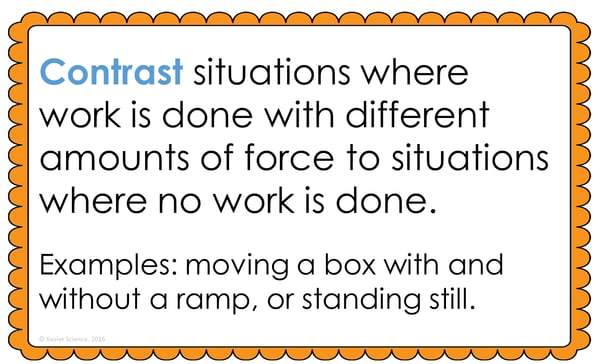
Afterwards, the teacher will help to clear any misconceptions their students may have about work. A common but major misconception, for example, is that students will think that just because effort is exerted that work has been done. This is partially true, and a good life lesson where work outside of the physics term is concerned, but doesn’t tell the whole story.
Estimated Class Time for the Engagement: 20-30 minutes
EXPLORATION
With nine stations in total, you can introduce work to your middle school students in a variety of ways! Four of these stations are considered input stations where students will learn new information about work, and four of the stations are output stations where students will be demonstrating their mastery of the lesson's material. A bonus station offers challenges for your early finishers and independent learners. You can read about how I set up the station labs here.
Watch It!
At this station, students will be watching a short video explaining work. Students will then answer questions related to the video and record their answers on their lab station sheet. For example: What is the formula for work? Name one example from the video of work being done. Is any work being done if the object does not move?
Read It!
This station will provide students with a one-page reading about work. Students will also learn about the components involved in order to calculate to see if work is done or not. There are four follow-up questions that the students will answer to demonstrate their comprehension of the reading material.
Explore It!
Students will be working in pairs to better understand work. In this station, students manipulate objects as they conduct certain tasks and record their movements and the amount of force being used. Students will follow the steps and record their observations on their lab sheet.
Research It!
The research station will allow students to explore an interactive web page that helps them to understand if work is being done using another PheT simulation with a ramp. Students will be instructed to complete a few tasks and record answers on their lab sheets.
Organize It!
Students at this station will match the sets of cards. Sets include a scenario in which students need to calculate work and the answer card. Once students have completed their organization, the teacher will check their understanding.
Illustrate It!
Your visual students will love this station. Students are to draw a picture that demonstrates their knowledge of work. Their drawing will have the force labeled, and the distance the object is moved. Students will also show how they calculated work being done in their illustration.
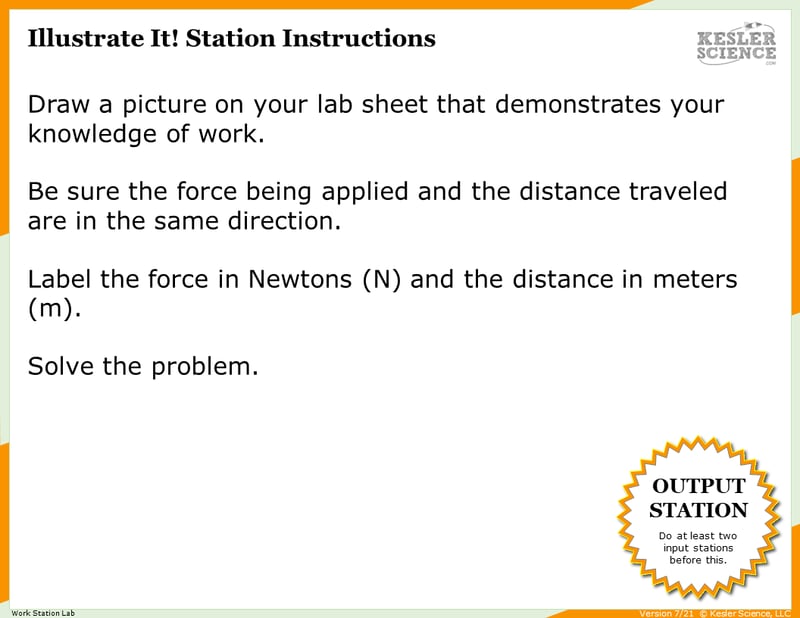
Write It!
Students who can answer open-ended questions about the lab truly understand the concepts that are being taught. At this station, the students will be answering three task cards: Describe what work is as it relates to science. How do you calculate work? Are you doing work if the force applied is in a different direction than the movement of the object? Why?
Assess It!
The Assess It station is where students will go to prove mastery over the concepts they learned in the lab. The questions are set up in a standardized format with multiple choice answers. Some questions include: Which person is not doing work? How much work is done on a dresser that was pushed 10.5m with 150N of force? What is the formula used to calculate work? How much work is done on a bag of trash that was lifted 1.5m with 600N of force?
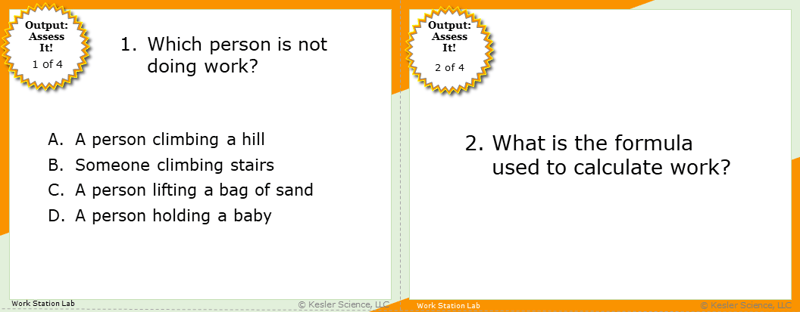
Challenge It! - Bonus Station
Early finishers and advanced students will love the extension activities in this station. Four activity choices offer them ways to expand their learning through mini-games and mini-projects.
Estimated Class Time for the Exploration: One or two 45-minute class periods
EXPLANATION
The explanation activities will become much more engaging for your class once they’ve completed the exploration station lab. During the explanation piece of the lesson, the teacher will be clearing up any misconceptions their students may have about work with a variety of materials. These materials include on-level and modified versions of the interactive presentation (may be used individually or projected), anchor charts, and paper or digital interactive notebook activities. If you have students that need modified notes, the 5E lessons come equipped to help give every student access to the lesson.
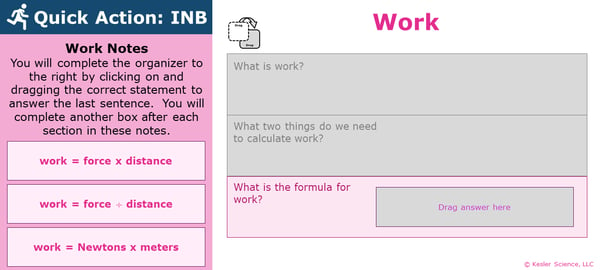
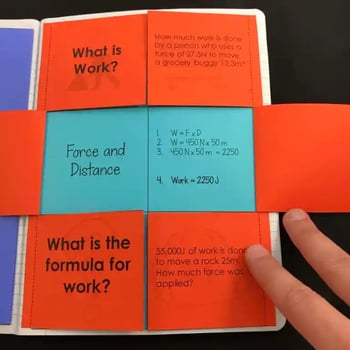
Interactive notebook samples: Above-left is a digital INB activity slide; above-right is an example of the paper INB activities.
The students will also be interacting with their journals while taking notes from the PowerPoint. If you have students that need modified notes, the 5E lessons come equipped to help give every student access to the lesson.
Estimated Class Time for the Exploration: Two or three 45-minute class periods
ELABORATION
The elaboration section of the 5E method of instruction gives students choices that allow them to prove they’ve mastered the concepts behind the lesson. When students are given a choice, they’re much more enthusiastic and invested in the project than they are when their teachers choose their projects for them. There are a total of nine choices to demonstrate understanding of work. A separate set of choices that offer more teacher support are also available for students that need them. Rubrics guide students to doing their best work and assist in grading.

Estimated Class Time for the Elaboration: Two or three 45-minute class periods (can also be used as an at-home project)
EVALUATION
The final piece of the 5E model is to evaluate student comprehension. Included in every 5E lesson is a homework assignment, assessment, and modified assessment. Research has shown that homework needs to be meaningful and applicable to real-world activities in order to be effective. When possible, I like to give open-ended assessments to truly gauge the student’s comprehension.
Estimated Class Time for the Elaboration: One 45-minute class period
DOWNLOAD THE FULL LESSON NOW
Download Over $100 in FREE Resources
For Middle School Science
Simply create a login below and gain immediate access to a selection of our Kesler Science product line worth $100 - for FREE. There's a full version of every product type! You'll also join tens of thousands of middle school science teachers who receive timely tips and strategies straight to their inbox.







